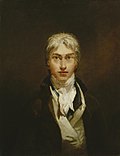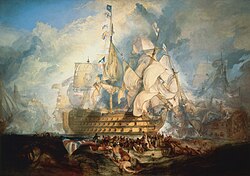File:The Battle of Trafalgar, 21 October 1805 RMG L8148-002.jpg

Original file (1,280 × 901 pixels, file size: 1,023 KB, MIME type: image/jpeg)
This is a file from the Wikimedia Commons. Information from its description page there is shown below.
Commons is a freely licensed media file repository. You can help.
Summary
| J. M. W. Turner: The Battle of Trafalgar
|
|||||||||||||||||||||||||||
|---|---|---|---|---|---|---|---|---|---|---|---|---|---|---|---|---|---|---|---|---|---|---|---|---|---|---|---|
| Artist |
|
||||||||||||||||||||||||||
| Title |
label QS:Les,"La Batalla de Trafalgar"
label QS:Lfr,"La Bataille de Trafalgar"
label QS:Lca,"La Batalla de Trafalgar"
label QS:Lde,"Die Seeschlacht von Trafalgar am 21. Oktober 1805"
label QS:Lsq,"Beteja e Trafalgarit (pikturë)"
label QS:Lzh,"特拉法加海戰"
label QS:Lda,"The Battle of Trafalgar"
label QS:Lja,"トラファルガーの海戦 (ターナー)"
label QS:Larz,"معركه الطرف الاغر"
label QS:Lpl,"Bitwa pod Trafalgarem"
label QS:Luk,"Трафальгарська битва"
label QS:Lnl,"The Battle of Trafalgar"
label QS:Lsv,"Slaget vid Trafalgar 21 oktober 1805"
label QS:Lel,"Η Μάχη του Τραφάλγκαρ"
label QS:Lhe,"קרב טרפלגר"
label QS:Lit,"La battaglia di Trafalgar"
label QS:Lar,"معركة الطرف الأغر" |
||||||||||||||||||||||||||
| Object type |
painting |
||||||||||||||||||||||||||
| Genre |
history painting |
||||||||||||||||||||||||||
| Description |
English: The Battle of Trafalgar, 21 October 1805 This is Turner’s only work by ‘royal command’ and the largest and most publicly controversial painting of his career. George IV gave him the commission late in 1822 on the advice of Sir Thomas Lawrence, President of the Royal Academy. It was to form a naval pair with Philippe-Jacques de Loutherbourg’s 1795 view of The Battle of the Glorious First of June 1794, in a patriotic post-war redecoration of the State Rooms at St James’s Palace. Lawrence and George Jones – both Turner’s friends – were also represented, the former by his portrait of King George III and the latter by paintings of Wellington’s victories at Vittoria and Waterloo. Turner did an unusual amount of practical research for this work, which is his most complex tribute to Nelson, of whom he was a great admirer. He already had sketches of 'Victory', made on her return to England with Nelson’s body in December 1805 for his earlier 'The Battle of Trafalgar', painted in 1806-08. For this picture he borrowed a plan of the ship from the Admiralty and asked the marine artist J. C. Schetky, at Portsmouth, to make further sketches of her there. Also unusually, he did two preparatory oil studies (now in the Tate). The finished work combines a number of incidents from different times in the action, within a more symbolic conception. Nelson’s presence, mortally wounded, is only implied in the highlighted crowd around 'Victory’s' mainmast. This powerful absence is prefigured by the smallness of Nelson’s figure, and those around him, beneath similarly towering masts, in the 1806-08 picture. The small human scale is also a response to de Loutherbourg’s painting, since both in different ways contrast a mass of vulnerable figures with the great floating fortresses in which they are contesting national dominance on a mutually hostile sea. In 'The Harbours of England' (1856, p. 16) Ruskin grasped this elemental component when he likened the uncontrollability of the ship’s sails, as Turner shows them, to ‘as many thunderclouds’, most of 'Victory’s' falling with her foremast and at the same time as Nelson. Also symbolically, the falling mast bears his white vice-admiral’s flag, while the code flags spelling ‘d-u-t-y’ – both the last word of his famous Trafalgar signal and the last coherent thought he spoke (‘Thank God I have done my duty’) – are coming down from the mainmast. On the right is the French 'Redoutable', from which Nelson was shot, surrendered and sinking, although she in fact went down in the storm after the battle. British seamen in the foreground boats raise a cheer, unaware of the tragedy behind in 'Victory', herself shown on an exaggerated scale as a dominating symbol of British sea power. Other men try to save friends and foes alike from a darkly heaving sea, in which a tangle of floating rigging resembles a monster’s head and a Union flag is spread out above, as if to cover the fallen. Below the surface loom fragments of Nelson’s motto, ‘Palmam qui meruit ferat’. This can translate as ‘Let him who has earned it bear the Palm’, or, in the circumstances, ‘the price of glory is death’. That the cost is equal for the common sailor as much as the admiral is thrust into the viewer’s face by the dead seaman arching out backwards from the picture plane, in the centre, at what would have been original eye level in St James’s Palace. In imposing recession beyond 'Victory' on the left are the Spanish four-decker 'Santissima Trinidad' and the 'Bucentaure', flagship of Admiral Villeneuve, overall commander of the enemy Combined Fleet. Further left, the French 'Achille', 74 guns, is on fire with the bow of the 'Neptune' just coming into the frame. Her sister the 'Fighting Temeraire' , as Turner called her in his famous picture of 1839 is on the far right, lost in smoke apart from her white ensign. On delivery in 1824 the painting provoked court criticism for its non-chronological approach to Nelson’s victory, and its powerful allusions to the blood price of Britain’s triumph, at Trafalgar and more generally in becoming the world’s dominant sea power. Ambassadors used to classically heroic treatments are said to have sneered at it and seamen, including Sir Thomas Hardy, 'Victory’s' captain, have always criticized it on technical grounds. Turner himself later considered the picture spoilt by the eleven unpaid days that he spent at St James’s adjusting it to the views of Admiralty men and he credited the King’s naval brother, the Duke of Clarence (William IV from 1830), with the only sensible comments, despite a sharp exchange with him at the time. While George IV, when Prince of Wales, had acquired the cooler and more conventionally theatrical de Loutherbourg in Carlton House, Turner’s fierily spectacular but ambivalent pendant proved an embarrassment at St James’s. It was also probably mismatched there – at least to the King’s polished taste – with the adjacent works by Jones and his favourite portraitist, Lawrence. In late 1829 he presented it, with the de Loutherbourg, as his final gifts to the Naval Gallery at Greenwich Hospital. It has been at Greenwich ever since, and remains to some extent a focus of recurring division between ‘sea dogs’ and art historians, admirers of Nelson and of Turner. |
||||||||||||||||||||||||||
| Date | 1822 | ||||||||||||||||||||||||||
| Medium |
oil on canvas |
||||||||||||||||||||||||||
| Dimensions | Painting: 2615 x 3685 mm; Frame: 3086 mm x 4179 mm x 195 mm | ||||||||||||||||||||||||||
| Collection |
institution QS:P195,Q7374509
|
||||||||||||||||||||||||||
| Current location | |||||||||||||||||||||||||||
| Accession number |
BHC0565 (Royal Museums Greenwich) |
||||||||||||||||||||||||||
| References | |||||||||||||||||||||||||||
| Source/Photographer | http://collections.rmg.co.uk/collections/objects/12057 | ||||||||||||||||||||||||||
| Permission (Reusing this file) |
The original artefact or artwork has been assessed as public domain by age, and faithful reproductions of the two dimensional work are also public domain. No permission is required for reuse for any purpose. The text of this image record has been derived from the Royal Museums Greenwich catalogue and image metadata. Individual data and facts such as date, author and title are not copyrightable, but reuse of longer descriptive text from the catalogue may not be considered fair use. Reuse of the text must be attributed to the "National Maritime Museum, Greenwich, London" and a Creative Commons CC-BY-NC-SA-3.0 license may apply if not rewritten. Refer to Royal Museums Greenwich copyright. |
||||||||||||||||||||||||||
| Other versions |
|
||||||||||||||||||||||||||
| Identifier InfoField | Greenwich Hospital Collection number: GH98 Loan File Number: Y2000.023 file number: 4G10.031 id number: BHC0565 |
||||||||||||||||||||||||||
| Collection InfoField | Oil paintings | ||||||||||||||||||||||||||
Licensing
|
This is a faithful photographic reproduction of a two-dimensional, public domain work of art. The work of art itself is in the public domain for the following reason:
The official position taken by the Wikimedia Foundation is that "faithful reproductions of two-dimensional public domain works of art are public domain".
This photographic reproduction is therefore also considered to be in the public domain in the United States. In other jurisdictions, re-use of this content may be restricted; see Reuse of PD-Art photographs for details. | |||||
Captions
Items portrayed in this file
depicts
1822
File history
Click on a date/time to view the file as it appeared at that time.
| Date/Time | Thumbnail | Dimensions | User | Comment | |
|---|---|---|---|---|---|
| current | 20:57, 1 October 2017 |  | 1,280 × 901 (1,023 KB) | Fæ | Royal Museums Greenwich Oil paintings (1822), http://collections.rmg.co.uk/collections/objects/12057 #2002-1 |
File usage
There are no pages that use this file.
Metadata
This file contains additional information, probably added from the digital camera or scanner used to create or digitize it.
If the file has been modified from its original state, some details may not fully reflect the modified file.
| Camera manufacturer | Hasselblad |
|---|---|
| Camera model | Hasselblad H3DII-39MS - Hasselblad H3D |
| Author | Camera User |
| Exposure time | 4/1 sec (4) |
| F Number | f/12 |
| ISO speed rating | 50 |
| Date and time of data generation | 2015-03-11T09:28:28 |
| Lens focal length | 80 mm |
| Width | 15,020 px |
| Height | 10,570 px |
| Bits per component |
|
| Compression scheme | Uncompressed |
| Pixel composition | RGB |
| Orientation | Normal |
| Number of components | 3 |
| Horizontal resolution | 72 dpi |
| Vertical resolution | 72 dpi |
| Data arrangement | chunky format |
| Software used | Adobe Photoshop CS6 (Macintosh) |
| File change date and time | 09:15, 19 March 2015 |
| Exposure Program | Manual |
| Exif version | 2.1 |
| Date and time of digitizing | 2015-03-11T09:28:28 |
| APEX shutter speed | −2 |
| APEX aperture | 7.1699249967933 |
| Maximum land aperture | 3.169925 APEX (f/3) |
| Subject distance | 7.666 meters |
| Metering mode | Center weighted average |
| Flash | Flash did not fire |
| Color space | Uncalibrated |
| Focal plane X resolution | 1,470.59 |
| Focal plane Y resolution | 1,470.59 |
| Focal plane resolution unit | 3 |
| Focal length in 35 mm film | 56 mm |
| Lens used | HC 80 |
| Serial number of camera | DM58244248 |
| Date metadata was last modified | 09:15, 19 March 2015 |
| Unique ID of original document | xmp.did:01801174072068118083D54AFABB007C |
| IIM version | 4 |




